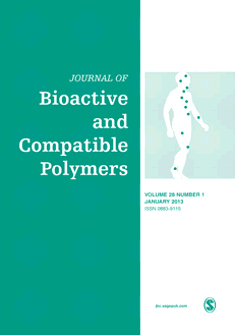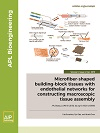
JOURNAL OF BIOMEDICAL MATERIALS RESEARCH PART B-APPLIED BIOMATERIALS
Scope & Guideline
Exploring New Horizons in Applied Biomaterials
Introduction
Aims and Scopes
- Biomaterial Development and Characterization:
The journal emphasizes the synthesis, processing, and characterization of novel biomaterials, including polymers, ceramics, and composites, aimed at improving clinical outcomes. - Tissue Engineering and Regenerative Medicine:
Research articles often address the use of biomaterials in tissue engineering applications, focusing on scaffolds that promote cell attachment, proliferation, and differentiation for tissue regeneration. - Drug Delivery Systems:
A significant focus is on the development of biomaterials that serve as drug delivery systems, including controlled release mechanisms and targeted delivery approaches for therapeutic agents. - In Vivo and In Vitro Evaluations:
The journal publishes studies that involve both in vitro and in vivo assessments of biomaterials to evaluate their performance, safety, and efficacy in medical applications. - Interdisciplinary Approaches:
Research often integrates materials science, biology, and engineering, highlighting the collaborative nature of advancements in biomedical materials.
Trending and Emerging
- Smart Biomaterials:
There is an increasing focus on the development of smart biomaterials that respond to environmental stimuli, such as pH, temperature, or light, to enhance their functionality in medical applications. - 3D Bioprinting:
Research involving 3D bioprinting techniques for creating complex tissue structures is trending, reflecting the demand for customizable and patient-specific solutions in regenerative medicine. - Antibacterial and Antimicrobial Materials:
A significant increase in studies focused on the development of biomaterials with inherent antibacterial properties is evident, addressing the pressing issue of infection in implants and medical devices. - Nanotechnology in Biomaterials:
The incorporation of nanotechnology into biomaterials research is on the rise, with studies exploring the effects of nanoscale modifications on the properties and performance of biomaterials. - Biomimetic Approaches:
There is a growing interest in biomimetic designs that replicate the natural extracellular matrix, enhancing the integration and functionality of synthetic biomaterials in the body.
Declining or Waning
- Traditional Biomaterials:
There is a noticeable decline in research focused exclusively on traditional biomaterials without modification, as newer, more advanced materials and composites are prioritized. - Basic Biocompatibility Studies:
Research that solely assesses the basic biocompatibility of materials without exploring their functional applications or enhancements is becoming less frequent. - Conventional Drug Delivery Methods:
The exploration of conventional drug delivery systems is waning, with a shift towards more innovative and complex delivery mechanisms that enhance therapeutic efficacy. - Animal Models for Testing:
The reliance on traditional animal models for testing biomaterial efficacy is decreasing, as there is a growing trend towards developing alternative in vitro models that better mimic human physiology. - Single-Function Materials:
Research focusing on biomaterials designed for a single function (e.g., only for structural support) is declining, as multifunctional materials that address multiple clinical needs gain prominence.
Similar Journals

JOURNAL OF BIOACTIVE AND COMPATIBLE POLYMERS
Exploring the Intersection of Biology and MaterialsJOURNAL OF BIOACTIVE AND COMPATIBLE POLYMERS, published by SAGE PUBLICATIONS LTD, serves as a pivotal platform for disseminating innovative research in the fields of bioengineering, biomaterials, materials chemistry, and polymers. With an ISSN of 0883-9115 and an E-ISSN of 1530-8030, this journal is committed to the advancement of knowledge relating to the interaction of polymers within biological systems and their compatibility in various applications. Operating since 1986, the journal has garnered a respectable presence, ranked in the Q3 quartile across multiple categories in 2023, indicating its relevance and contribution to these dynamic fields. Although not open access, the journal ensures that high-quality research is accessible to subscribers and institutions, reinforcing its importance for researchers, professionals, and students aiming to stay abreast of advancements in polymer science and biocompatibility. By fostering interdisciplinary communication and collaboration, the JOURNAL OF BIOACTIVE AND COMPATIBLE POLYMERS continues to play a crucial role in shaping the future of material applications in health, technology, and industry.

Materials Science & Engineering C-Materials for Biological Applications
Innovating the intersection of materials science and biology.Materials Science & Engineering C-Materials for Biological Applications is a premier journal published by ELSEVIER, dedicated to advancing the field of biomaterials through interdisciplinary research. With a robust ISSN of 0928-4931, this journal has made its mark in the realms of Chemical Engineering and Materials Science, achieving impressive Scopus rankings within its categories, namely Rank #16/151 in Bioengineering (89th percentile) and Rank #13/112 in Biomaterials (88th percentile). Although the journal's coverage in Scopus has been discontinued since 2021, it remains a critical resource for researchers, professionals, and students eager to explore innovative materials and their applications in biological contexts. The journal’s open access policy enhances its accessibility, fostering a global exchange of knowledge and inspiring future advancements in the field of materials science.

International Journal of Biomaterials
Shaping the future of healthcare with open access to biomaterials research.The International Journal of Biomaterials, published by HINDAWI LTD, is a premier platform for disseminating groundbreaking research in the fields of biomaterials and biomedical engineering. With an Open Access approach since 2009, this journal provides unhindered access to innovative studies and applications aimed at advancing medical technologies and improving patient outcomes. Notably ranked in the Q3 category for both Biomaterials and Biomedical Engineering in 2023, it serves as an essential resource for researchers, practitioners, and students alike. The journal's Scopus rankings, including a 49th percentile in Biomedical Engineering and a 40th percentile in Biomaterials, further underscore its growing prominence in the academic community. With contributions spanning from 2011 to 2024, the journal seeks to foster collaborative research and promote developments that enhance the understanding and application of biomaterials in healthcare.

APL Bioengineering
Exploring New Frontiers in Bioengineering ResearchAPL Bioengineering is a premier open-access journal published by AIP Publishing, dedicated to advancing the field of bioengineering and its interdisciplinary applications. Established in 2017, this journal serves as a vital platform for researchers, professionals, and students interested in the critical intersections of bioengineering, biomaterials, biomedical engineering, and biophysics. With an impressive impact factor and consistent rankings in the Q1 category across multiple domains, including biochemistry and materials science, APL Bioengineering has positioned itself among the top journals in its field. The journal aims to publish innovative original research, comprehensive reviews, and insightful case studies that further the understanding and application of bioengineering principles. Since its inception, APL Bioengineering has fostered a community of thought leaders, providing open access to ensure broad dissemination of knowledge and advancements that underpin the future of biomedical innovation.

Tissue Engineering Part C-Methods
Advancing the Frontiers of Tissue Engineering MethodologiesTissue Engineering Part C: Methods is a prestigious academic journal published by MARY ANN LIEBERT, INC, specializing in the dynamic and rapidly evolving fields of bioengineering and biomedical engineering. With an ISSN of 1937-3384 and E-ISSN 1937-3392, this journal provides a platform for the dissemination of cutting-edge research from 2008 to 2024, showcasing methodologies that advance the science of tissue engineering. Ranked in the second and third quartiles across several categories in 2023, including a notable Q2 in Biomedical Engineering, the journal is recognized for its contributions to the interface of biology and engineering. Additionally, it holds commendable Scopus ranks that highlight its influence and reach within the scientific community. Although it does not offer open access, the journal remains vital for researchers, professionals, and students seeking insightful articles that bridge the gap between theoretical research and practical application in tissues and regenerative medicine. With its rigorous peer-review process and commitment to quality, Tissue Engineering Part C: Methods continues to be an essential resource for those at the forefront of tissue engineering innovations.

Regenerative Biomaterials
Empowering Collaboration in Biomaterials ResearchRegenerative Biomaterials, published by Oxford University Press, serves as a premier platform for the dissemination of innovative research in the rapidly evolving field of biomaterials. Since its inception in 2014, this esteemed open-access journal has fostered a collaborative and diverse scientific community, providing free access to impactful articles that enhance our understanding of regenerative medicine and tissue engineering. With a commendable impact factor and ranking within the top quartiles of both Biomedical Engineering and Materials Science, it is recognized for its rigorous peer-review process and high-quality publications. The journal aims to bridge the gap between fundamental research and applied sciences, promoting advanced studies that contribute to clinical applications and regeneration strategies. Researchers, practitioners, and students alike are encouraged to engage with the journal’s content to foster interdisciplinary collaboration and drive future innovations in the biomaterials domain.

JOURNAL OF BIOMATERIALS APPLICATIONS
Exploring transformative materials for medical breakthroughs.JOURNAL OF BIOMATERIALS APPLICATIONS, published by SAGE PUBLICATIONS LTD, serves as a pivotal platform for the dissemination of cutting-edge research in the field of biomaterials and biomedical engineering. With an ISSN of 0885-3282 and an E-ISSN of 1530-8022, this journal has been a respected venue for scholarly communication since its inception in 1986. Aiming to provide comprehensive insights into the applications of biomaterials, this journal publishes high-quality articles that explore innovative materials and methodologies, thereby fostering advancements in medical technology and tissue engineering. The journal consistently ranks in the third quartile (Q3) for both Biomaterials and Biomedical Engineering categories, strengthening its position among the noteworthy academic resources available today. With a dedicated readership comprising researchers, industry professionals, and students, JOURNAL OF BIOMATERIALS APPLICATIONS plays a vital role in supporting knowledge exchange and scientific progress within these dynamic fields.

Biomaterials Research
Fostering collaboration in the world of biomaterials.Biomaterials Research, published by the American Association for the Advancement of Science, is a prominent open access journal established in 2014, dedicated to advancing the field of biomaterials. Based in the United Kingdom, this journal has swiftly become an essential platform for researchers and practitioners, offering groundbreaking insights in biomaterials, biomedical engineering, ceramics and composites, and miscellaneous medical fields. With its impressive Q1 ranking across multiple relevant categories in 2023 and its strong Scopus rankings, including a remarkable 90th percentile in the medicine category, Biomaterials Research showcases high-quality, peer-reviewed research designed to address both practical and theoretical challenges in biomaterials science. As an open access journal, it promotes wider dissemination and accessibility of research findings, crucial for fostering innovation and collaboration within the scientific community. Researchers, professionals, and students alike are encouraged to contribute, read, and engage with the latest developments in this dynamic field.

JOURNAL OF BIOMEDICAL MATERIALS RESEARCH PART A
Connecting researchers to the forefront of biomedical materials science.JOURNAL OF BIOMEDICAL MATERIALS RESEARCH PART A, published by WILEY, is a leading journal in the field of biomaterials and biomedical engineering, showcasing cutting-edge research that bridges the gap between material science and healthcare applications. With a robust 2023 impact factor reflecting its high-quality contributions, this journal is classified in the Q2 quartile for Biomaterials, Biomedical Engineering, and Ceramics and Composites, while achieving an impressive Q1 ranking in Metals and Alloys. The journal caters to a diverse readership, including researchers, professionals, and students, aiming to facilitate innovation and advancements in biocompatible materials and their applications in medical devices and tissue engineering. Access options for readers are available, ensuring the latest studies and findings are readily accessible to all stakeholders in this dynamic field. As it progresses towards its 2024 target, the JOURNAL OF BIOMEDICAL MATERIALS RESEARCH PART A continues to be an essential resource for anyone involved in the development and application of biomedical materials.

Bioactive Materials
Pioneering Research in Biomedical Engineering and BiotechnologyBioactive Materials, published by KEAI PUBLISHING LTD, stands as a leading Open Access journal in the fields of Biomaterials, Biomedical Engineering, and Biotechnology. Since its inception in 2016, this journal has rapidly ascended in prominence, currently holding a prestigious Q1 category ranking across multiple disciplines, reflecting its significant impact within the scientific community. With its E-ISSN 2452-199X, it spans a broad spectrum of research areas, contributing valuable insights to the ongoing discourse in bioactive materials and their applications. The journal's superior Scopus rankings further illustrate its influence, boasting impressive standings in engaging niches such as engineering and molecular biology. Bioactive Materials offers a vital platform for researchers, professionals, and students to disseminate and acquire cutting-edge knowledge, thus fostering innovation and collaboration in the rapidly evolving terrain of biomedicine. Its commitment to Open Access since 2016 enhances accessibility, ensuring that the burgeoning advancements in this field reach a global audience.